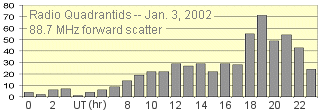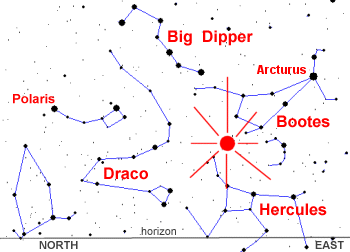QUADRANTID METEOR SHOWER


What's Up in Space -- 1 Jan 2003
METEOR WATCH
The annual Quadrantid meteor shower will soon be here. It's expected to peak during the
few hours around 23:00 UT (6 p.m. EST) on Jan. 3, 2003. Sky watchers in Asia and eastern
Europe are favored for this year's brief display of perhaps 100 meteors per hour.

(Animated gif, 397 kB)
4 januari 2002
Arjen en Jan l'Amie maakten op 3 januari 2002 dit filmpje van een Quadrantide (Bo÷tide) meteoor in Gemini. Gebruikte apparatuur: Ikegami CCD-camera en een 50 mm lens, opname met een time-lapse videorecorder.
What's Up in Space -- 4 Jan 2002
QUADRANTID METEORS
The annual Quadrantid meteor shower peaked on Thursday,
January 3rd. As expected, visual observers saw, at best,
a modest display (10 or so per hour); the Quadrantids were
overwhelmed this year by a glaring nearly-full Moon. Radio
meteor listeners, however, recorded plenty of "pings" --
that is, signals from radio stations reflected by ionized
meteor trails. It was a good year to listen to the
Quadrantids!

Above: Engineer Stan Nelson of Roswell, NM,
recorded more than 70 radio echoes per hour during the
Quadrantid maximum.
What's Up in Space -- 2 Jan 2002

Above: The northern sky on Jan. 3, 2001 at 4 a.m. local
time as viewed by an observer at mid-Northern latitudes.
The red dot is the Quadrantid radiant.
NASA Space Science News for Jan 1, 2000
During the 1999 Leonid meteor shower, astronomers watching the Moon saw flashes caused by meteorites striking the lunar surface. It was the first time such observations had ever been made. Another opportunity for amateur astronomers to watch and record lunar meteorite impacts may be just around the corner, on Jan. 4, 2000, when the Quadrantid meteor shower reaches its peak.
=========================================================== SKY & TELESCOPE'S NEWS BULLETIN - DECEMBER 30, 1999 ===========================================================
This year's display is predicted to reach maximum activity near 5:00 Universal Time which corresponds to midnight EST and 9pm (January 3) PST. European observers will have the radiant high in their morning skies while those of us on the east coast of North America will have the radiant low in the northeast. Regardless of your location, I would suggest commencing any Quadrantid watch at midnight and watching as long as possible. To see the most activity it would be wise to face at least half way up in the sky anywhere from due north to due east, whichever direction offers the darkest skies. The moon will be a very thin crescent and will not interfere with observing as it rises just before dawn. Be sure to protect yourself from the cold by wearing several layers of clothing and taking breaks when necessary.
Worthwhile activity from the Quadrantids is limited to the night of maximum activity. The nights before and after maximum activity offer only 1-2 shower members per hour while the remainder of the activity period (January 2-6) offers perhaps only 1-2 shower members per night.
More detailed information on observing meteor showers can be found on Sky & Telescope's web page at:
http://www.skypub.com/sights/meteors/meteors.shtml
If you get to see this interesting display be sure to let us know your totals at either:
or my personal email address at:
Clear Skies and Happy Year 2000!
Robert Lunsford
American Meteor Society
International Meteor Organization
NASA Space Science News for Dec. 28, 1999
One of the most intense and least observed annual meteor showers peaks on the morning of Jan. 4, 2000. The Quadrantids will be the first major meteor display of the New Year.
 Back to ASTRONET's home page
Back to ASTRONET's home page
 Terug naar ASTRONET's home page
Terug naar ASTRONET's home page